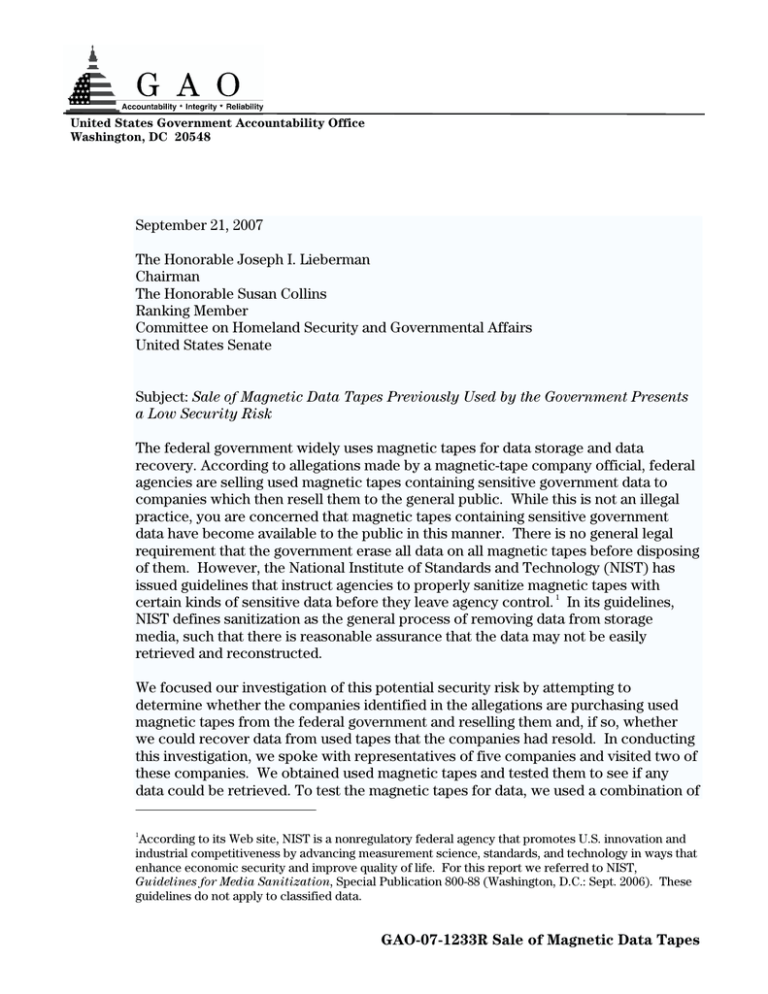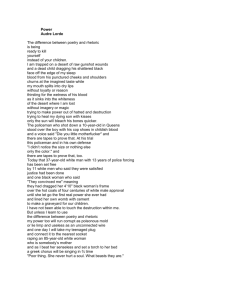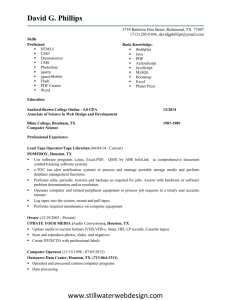September 21, 2007 The Honorable Joseph I. Lieberman Chairman
advertisement

United States Government Accountability Office Washington, DC 20548 September 21, 2007 The Honorable Joseph I. Lieberman Chairman The Honorable Susan Collins Ranking Member Committee on Homeland Security and Governmental Affairs United States Senate Subject: Sale of Magnetic Data Tapes Previously Used by the Government Presents a Low Security Risk The federal government widely uses magnetic tapes for data storage and data recovery. According to allegations made by a magnetic-tape company official, federal agencies are selling used magnetic tapes containing sensitive government data to companies which then resell them to the general public. While this is not an illegal practice, you are concerned that magnetic tapes containing sensitive government data have become available to the public in this manner. There is no general legal requirement that the government erase all data on all magnetic tapes before disposing of them. However, the National Institute of Standards and Technology (NIST) has issued guidelines that instruct agencies to properly sanitize magnetic tapes with certain kinds of sensitive data before they leave agency control. 1 In its guidelines, NIST defines sanitization as the general process of removing data from storage media, such that there is reasonable assurance that the data may not be easily retrieved and reconstructed. We focused our investigation of this potential security risk by attempting to determine whether the companies identified in the allegations are purchasing used magnetic tapes from the federal government and reselling them and, if so, whether we could recover data from used tapes that the companies had resold. In conducting this investigation, we spoke with representatives of five companies and visited two of these companies. We obtained used magnetic tapes and tested them to see if any data could be retrieved. To test the magnetic tapes for data, we used a combination of 1 According to its Web site, NIST is a nonregulatory federal agency that promotes U.S. innovation and industrial competitiveness by advancing measurement science, standards, and technology in ways that enhance economic security and improve quality of life. For this report we referred to NIST, Guidelines for Media Sanitization, Special Publication 800-88 (Washington, D.C.: Sept. 2006). These guidelines do not apply to classified data. GAO-07-1233R Sale of Magnetic Data Tapes commercially available equipment that a standard magnetic tape customer would own as well as specialized diagnostic equipment. We did not investigate all existing magnetic tape companies in the United States, but focused on the five companies referred to us in the allegations. We did not attempt to validate whether the companies we investigated disclosed all of their business with the federal government. Furthermore, we did not attempt to contact agencies to determine whether they sold tapes or to determine whether they complied with NIST guidelines when selling used magnetic tapes to companies. We did meet with NIST officials to discuss their guidelines for media sanitization. We performed our investigation from March through August 2007 in accordance with the quality standards for investigations as set forth by the President’s Council on Integrity and Efficiency. In summary, we could not find any comprehensible data on the used magnetic tapes we tested. We obtained these tapes from the only company (of the five we investigated) that told us it resells tapes purchased from the federal government. Officials at this company told us that, before reselling used tapes, most of them are sanitized using a process known as degaussing. The degaussing process completely destroys any data on a tape, preventing data recovery. However, the company told us that its process for sanitizing tapes differs when reselling certain high-capacitystorage tape formats. These formats contain a feature called a servo track, which cannot be degaussed without rendering the tape unusable. Consequently, tapes with servo tracks must be sanitized using a less thorough process known as overwriting. The company also told us that it strips the labels from used tapes before sanitizing them and that it was therefore impossible to determine whether any used tape sold by the company had originated with the federal government. Keeping this in mind, we obtained, from the company, four magnetic tapes with servo tracks and eight without. It is important to emphasize that there was no way to know whether we had obtained tapes that originated with the government—our intent was to test whether the tapes containing servo tracks could contain data after overwriting. We could not find any comprehensible data on any of the tapes using standard commercially available equipment and data recovery techniques, specialized diagnostic equipment, custom programming, or forensic analysis. Background The federal government has used magnetic tapes for data storage for over 50 years. Magnetic tapes are typically housed in cartridges or cassettes and accessed using a tape drive. Although current computer disk technology provides a viable storage medium for most applications, magnetic tape continues to provide the government with an inexpensive means of backing up mid- to large-sized mainframe systems in the event of a disaster or system failure. The evolution of magnetic tape has seen the creation of new tape formats, which has led to increased data storage capacity, speed, accessibility, and other innovations. See figure 1 for an example of different magnetic tape formats. Page 2 GAO-07-1233R Sale of Magnetic Data Tapes Figure 1: Examples of Standard Magnetic Tape Formats Source: GAO. Since some companies still manufacture magnetic tapes, government agencies, businesses, and individuals can purchase new tapes that reflect the latest innovations in magnetic tape technology. Used tapes may also be purchased at a discount price from many of the same companies that sell new tapes. A substantial secondary market exists for used magnetic tapes in the United States. Before a company resells a used tape on the secondary market, the company typically processes the tape and certifies that it can be reused. There is no standard definition of a certified tape. However, to ensure that used tapes are free of data when they are resold, companies use two basic methods for sanitizing a magnetic tape—overwriting and degaussing. While overwriting involves layering randomized alphanumeric characters on top of the original information, degaussing destroys the original information entirely. Overwritten data may still be recoverable through forensic analysis. Alternatively, when a magnetic tape is degaussed, the carefully arrayed magnetic particles representing the data are scrambled. This renders the information on the tape completely unrecoverable. There does not appear to be any general legal requirement for federal agencies to sanitize all data on all used magnetic tapes prior to selling them to the public. According to NIST, agencies have four options for sanitizing used magnetic tapes depending on the sensitivity of the information contained on them. These four options are disposal, overwriting (also called clearing), degaussing (also called purging), and physical destruction. Disposal is the process of simply throwing away a used magnetic tape without any special disposition given to it. According to NIST, some magnetic tapes can be simply thrown out if disclosure of the data would have no impact on organizational mission and would not damage organizational assets, Page 3 GAO-07-1233R Sale of Magnetic Data Tapes result in financial loss, or result in harm to any individuals. If an agency determines a magnetic tape contains data that would meet any of these criteria and could potentially have a negative impact if disclosed, NIST guidelines recommend that tapes be degaussed or destroyed before leaving an agency’s control. Tapes that are simply overwritten may contain data that are still recoverable using forensic analysis. The final form of sanitization, physical destruction, should be undertaken due to the high security categorization of the information or for environmental reasons, and could include disintegration, incineration, pulverizing, shredding, and melting. Results of Investigation All five companies we investigated sell products to the government. However, only one company out of the five disclosed that it resells tapes purchased from the federal government. According to documents received from this company, they bought tapes from agencies including the National Oceanic and Atmospheric Administration, the Federal Reserve Bank, and the U.S. Air Force. They then resold the tapes on the secondary market. It was outside the scope of this investigation to determine what kind of sanitization process, if any, the tapes had undergone prior to leaving their agencies of origin—in other words, we do not know whether agencies followed NIST guidelines before selling their used tapes. According to officials at the company that buys tapes from the government, it sanitizes most tapes using the degaussing process before certifying and reselling them. However, its process for erasing tapes differs when processing tapes that contain servo tracks. These formats (e.g., LTO2 and 9840 tapes) cannot be degaussed without rendering the tape unusable; tapes with servo tracks must be sanitized using the less thorough overwriting process. Furthermore, company officials told us that they strip the labels from used tapes before sanitizing them and that it is therefore impossible to know whether any used tape purchased from the company had originated with the federal government. To find out whether tapes sold by this company could contain recoverable data, we obtained and tested 12 used tapes from this company.2 It is important to emphasize that there was no way to know whether we had obtained tapes that originated with the government—our intent was to test whether the tapes containing servo tracks could contain data after overwriting. While four of these tapes—two LTO2 and two 9840 tapes—contained servo tracks, the others did not. The first phase of our test was to use standard commercially available equipment to read the tapes. We could not find any data on the tapes using this method. Continuing with commercially available equipment, we then used several standard data recovery techniques and commands to attempt to access data on the tapes. After 2 days of work we could not find any data on the tapes using this method. The final phase of our test was to use specialized diagnostic equipment, custom programming, and forensic analysis. After 5 business days, we were able to recover small amounts of data (including information related to graphic files) from the four tapes containing servo tracks— LT02 and 9840 tapes. The data we recovered were incomprehensible and we could not confirm whether or not any of the tapes had originated from the federal government based on the data. We are aware that further work could have been performed to attempt to recover data from these tapes, however, this work would 2 We obtained a total of 12 tapes—2 of each of the LTO2, 9840, 3480, 3490E, 3590, and 3590E formats. Page 4 GAO-07-1233R Sale of Magnetic Data Tapes have represented a very expensive, intensive effort spanning months and, potentially, years. Conclusion Based on the limited scope of work we performed, we conclude that the selling of used magnetic tapes by the government represents a low security risk, especially if government agencies comply with NIST guidelines in sanitizing their tapes. Even if some data were recoverable from some tape formats that had been overwritten to preserve their servo tracks, the data may not be complete or even decipherable. Generally this investigation does raise some questions about the lack of oversight regarding the sanitization or disposal of used magnetic tapes by agencies. However, the scope of our investigation was not large enough to project our conclusions beyond the tape formats we investigated. This report will be available at no charge on our Web site at http://www.gao.gov. If you or your staff have any questions about this report, please contact me at (202) 5127455 or kutzg@gao.gov. Contact points for our Offices of Public Affairs and Congressional Relations may be found on the last page of this report. GAO staff who made major contributions to this report include John Ryan, Assistant Director; Monica Perez Antatalio, Paul Desaulniers, Matthew Harris, Hal Lewis, Andrew McIntosh, Kevin Metcalfe, and Kristen Plungas. Gregory D. Kutz Managing Director, Forensic Audits and Special Investigations Keith Rhodes Chief Technologist (192240) Page 5 GAO-07-1233R Sale of Magnetic Data Tapes GAO’s Mission The Government Accountability Office, the audit, evaluation, and investigative arm of Congress, exists to support Congress in meeting its constitutional responsibilities and to help improve the performance and accountability of the federal government for the American people. GAO examines the use of public funds; evaluates federal programs and policies; and provides analyses, recommendations, and other assistance to help Congress make informed oversight, policy, and funding decisions. GAO’s commitment to good government is reflected in its core values of accountability, integrity, and reliability. Obtaining Copies of GAO Reports and Testimony The fastest and easiest way to obtain copies of GAO documents at no cost is through GAO’s Web site (www.gao.gov). Each weekday, GAO posts newly released reports, testimony, and correspondence on its Web site. To have GAO e-mail you a list of newly posted products every afternoon, go to www.gao.gov and select “E-mail Updates.” Order by Mail or Phone The first copy of each printed report is free. Additional copies are $2 each. A check or money order should be made out to the Superintendent of Documents. GAO also accepts VISA and Mastercard. Orders for 100 or more copies mailed to a single address are discounted 25 percent. Orders should be sent to: U.S. Government Accountability Office 441 G Street NW, Room LM Washington, DC 20548 To order by Phone: Voice: TDD: Fax: (202) 512-6000 (202) 512-2537 (202) 512-6061 Contact: To Report Fraud, Waste, and Abuse in Federal Programs Web site: www.gao.gov/fraudnet/fraudnet.htm E-mail: fraudnet@gao.gov Automated answering system: (800) 424-5454 or (202) 512-7470 Congressional Relations Gloria Jarmon, Managing Director, JarmonG@gao.gov, (202) 512-4400 U.S. Government Accountability Office, 441 G Street NW, Room 7125 Washington, DC 20548 Public Affairs Susan Becker, Acting Manager, BeckerS@gao.gov, (202) 512-4800 U.S. Government Accountability Office, 441 G Street NW, Room 7149 Washington, DC 20548 PRINTED ON RECYCLED PAPER This is a work of the U.S. government and is not subject to copyright protection in the United States. The published product may be reproduced and distributed in its entirety without further permission from GAO. However, because this work may contain copyrighted images or other material, permission from the copyright holder may be necessary if you wish to reproduce this material separately.




